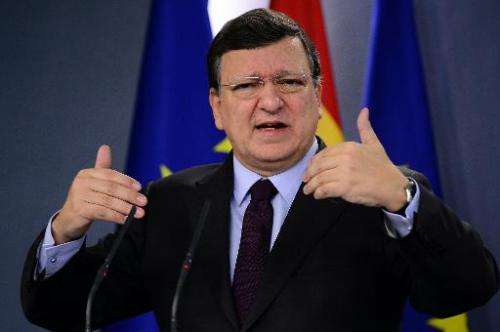European Commission President Jose Manuel Barroso speaks during a press conference after a meeting at the Moncloa Palace in Madrid on January 17, 2014
The EU will announce climate change targets for 2030 next week but sharp differences over priorities and an unwillingness to take the lead while global rivals hang back may result in a modest compromise deal.
The 2020 programme is widely judged a success but some argue this means the European Union can now actually ease up to focus on a struggling economy while others want a more ambitious package to keep the momentum going.
European Commission head Jose Manuel Barroso will unveil the new package on Wednesday, ahead of a March EU leaders summit, and is also expected to propose new rules on the controversial 'fracking' extraction of shale gas.
Barroso will also address ways to boost the EU's carbon dioxide emissions market, meant to help combat global warming but which has so far disappointed.
The current 20-20-20 EU programme is based on a binding 20 percent cut in CO2 emissions by 2020, compared with 1990 levels.
Member states are also supposed to source 20 percent of their energy from renewables and achieve a 20 percent energy efficiency gain by the same date.
The European Parliament's environment committee wants a more ambitious and binding 40-30-40 package, but such targets are opposed by those who insist that national governments should decide their country's energy mix, not the EU.
EU Climate Commissioner Connie Hedegaard meanwhile backs the CO2 reduction target of 40 percent.
"That implies an additional but not excessive effort," said one source close to the negotiations ahead of Wednesday's formal announcement.
By end-2012, the EU had cut CO2 emissions by 18 percent, putting it on course for perhaps 24 percent by 2020.
Perversely, this success takes some of the pressure off for a 40 percent target on the view the EU is already doing more than its fair share while competitors such as China and India lag behind.
EU Energy Commissioner Guenther Oettinger and Industry Commissioner Antonio Tajani are ready to accept a 35 percent reduction target, sources said.
"Nothing has been decided yet," said one source while another said a figure of 38 percent was on the table.
If the CO2 reduction target is 40 percent, then renewables might be fixed at 27 percent; if the cut is 35 percent, renewables could be 25 percent, the source close to the negotiations said.
"Renewables have become a bargaining chip," the source said, with many also opposed to their being made a binding target.
Economic powerhouse Germany is switching into renewables as its closes down its nuclear power plants and so is anxious to ensure its peers do not get a free ride to its disadvantage.
"For this reason, Germany wants 28 binding national targets (for renewables) but France, Britain, Spain, Poland and most East European countries will not accept having their energy mix dictated to them," the source close to the negotiations said.
Sigmar Gabriel, German vice chancellor who also heads the new economy and energy super ministry, showed no signs of compromising earlier this week.
"Without a binding CO2 reductions target and a binding target for renewables development, we would never have achieved the progress we have made," Gabriel said.
Europe must stick to this course, in light of international climate negotiations but also to push through the "reorganisation" of German and European energy of systems.
"A clear and binding 30 percent 2030 target for the development of renewable energy is part of that," Gabriel said.
An official from another large EU member state said that might be difficult.
"We cannot fix a target without addressing the distortions caused by the various support mechanisms, state aid and pricing for renewable energy," said the official who asked not to be named.
"There is a problem with Germany," said another official, noting that Berlin was already in trouble with the EU over the subsidies it offers to encourage the renewables sector.
© 2014 AFP























